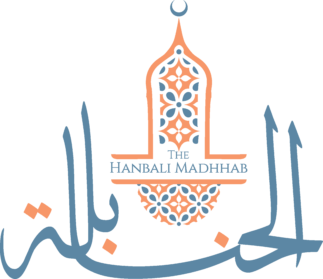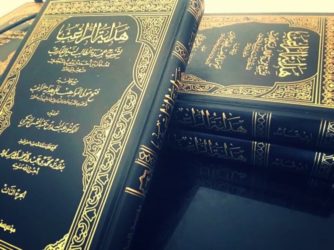Hidayah al-Raghib Li Sharh ‘Umdah al-Talib
by al-Imam al-‘Allamah al-Muhaqqiq, ‘Uthman b. Ahmad al-Najdi [Ibn Qa-id] (d. 1097 AH)
Who is Ibn Qa-id al-(r)?
He is the erudite Hanbali jurist, the Imam, the ‘Allamah, the author of many precious works. He is the author of the unequalled Hashiyah (marginalia) of Muntaha-l Iradat; a work which is a clear indication of his status and his juristic capabilities and his attentiveness to detail.
One of the major support he received in building this juristic personality of his are his main teachers who are Imams of Tahqiq; the two main ones being, al-Imam al-‘Allamah Muhammad al-Khalwati (the author of the another brilliant Hashiyah of al-Muntaha) and al-Imam al-Muhaqqiq, ‘Abdullah al-Dahalan.
A quick overview of Hidayah al-Raghib:
It is the amazing commentary on the Fiqh manual ‘Umdah al-Talib Li Nail al-Ma-arib by the great Imam, Mansur b. Yunus al-Buhuti. Shaykh ‘Uthman explained this book masterfully, both in terms of the wording of the book and in terms accuracy, thus, becoming one of the invaluable books of the Hanbali Madhhab. This is how the book was described by Ibn Badran (rahimahullah) in al-Madhkhal and Ibn Humaid (rahimahullah) in al-Suhub al-Wabilah.
The main distinguishing factors:
1) Its value simply due to it being a commentary of ‘Umdah al-Talib, which is the Fiqh manual in which al-Buhuti (rahimahullah) poured the essence of his lifelong experience as a master Hanbali jurtist explaining, editing, refining and verifying (the major books of the Madhhab) in a manner that no one could parallel him in his generation of Hanbali scholars.
2) The short link between the commentator and the author of the original. Sh. ‘Uthman was from the main students of al-Khalwati and al-Khalwati was from the main students al-Imam al-Buhuti, just like pearls organised on a string of Fiqh!
3) A focus on mentioning legal maxims, and conditions, exceptions, and reasoning on different issues of Fiqh. These are some of the most important things for an intermediate student.
4) Meticulous care when stating textual and rational evidences.
5) Full of valuable and rare insights and often even beneficial additions from the Shaykh himself which you probably wouldn’t find elsewhere; for instance:
i) his own Ijtihadat and corrections which gradually instils the essence of Fiqh within the student and hones the mind to look into and contemplate over opinions.
ii) summarising the unique opinions of authoritative Hanbali scholars along with their reasoning; from the benefits of doing so: the student gets to repetitively read and hear the names of different books of the Madhhab, the authors, and the status of these books. It will also get the student accustomed to the methodology of a jurist like Ibn Qa-id (rahimahullah) when it comes to dealing with different opinions.
iii) touching on some important issues and hinting his own inclinations, like how he did for some issues relating to Aqidah and Usul al-Fiqh.
iv) accuracy in vowelizing important words and their I’rab
v) poetizing conditions
vi) attributing opinions to the Companions by name/number
The little that has been mentioned above, including many other things, are very beneficial for the intermediate student of the Madhhab as it helps in develop their juristic personality so that it matures and it helps the student to slowly start expanding his scope little by little.
Between Hidayah al-Raghib and al-Rawd al-Murbi’:
From the greatest features of this book is that it matches al-Rawd al-Murbi’ (of Sh. Mansur al-Buhuti, rahimahullah) to a great extent, on top of being very organised and well presented, something which al-Rawd lacks in spite of its great importance in the Madhhab. Hence, the student who thoroughly (key word) studies Hidayah al-Raghib can skip studying al-Rawd al-Murbi’. However, it is preferred that he still reads through al-Rawd al-Murbi’, along Hashiyah Ibn Fairuz, after or whilst studying Hidayah al-Raghib, for a combined benefit and also so that the intricacies of al-Rawd open up to the student with ease.
A point to note:
The major significance of Hidayah al-Raghib and al-Rawd al-Murbi’, and similar books, lies in them being them bridging the big gap between concise manuals like Dalil al-Talib, Zad al-Mustaqni’, ‘Umdah al-Talib and voluminous works like al-Muntaha, al-Iqna’, al-Ghayah. Furthermore, Hidayah al-Raghib and al-Rawd al-Murbi’ aren’t just mere commentaries in the sense that they just break down and explain the cryptic-manuals and mention the textual and rational evidences for every issue, rather, these two books are manuals in the form of a commentary and words are loaded with meaning and detail. This is the reason these books should be studied with expert teachers who can explain and clarify, and not by merely reading them by oneself.
** Is it true that Hidayah al-Raghib fails to maintain its quality as valuable and important commentary after the chapters of worship?
The student will notice that after the section of worship the insights, additional benefits, and digressions (which are from the things that really make this book stand out) are much less. However, one should never misunderstand this point to mean that this decreases its value as a commentary of Fiqh manual (‘Umdah al-Talib); it holds the same high status as a commentary of Fiqh manual like how al-Rawd is for Zad al-Mustaqni’ and does what al-Rawd does for Zad by mentioning conditions, exceptions, and reasoning behind the rulings in the manual. The book altogether is exceptional.
 6456total visits,5visits today
6456total visits,5visits today

